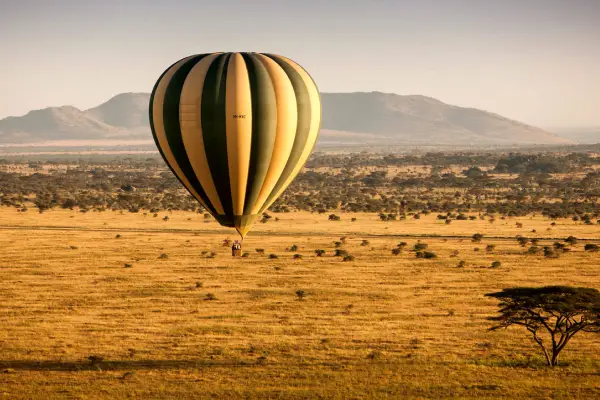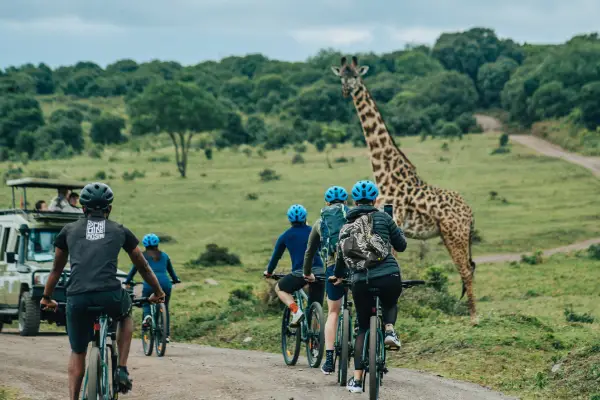100% refundable deposits
100% refundable deposits
Exploring the majestic landscapes of Tanzania on a safari is an experience like no other. However, understanding the Tanzania Safari Cost involved is essential for planning your adventure.
Typically, a budget Tanzania Safari Tour might cost around $250 per person per day. For those seeking a bit more comfort, mid-range Tanzania Safari Tours average about $400 per person per day, while a luxury experience can ascend to approximately $625 per day.
Acknowledged as one of Africa's premium destinations, the Tanzania Safari Cost reflects the unparalleled wildlife encounters and pristine natural settings you'll enjoy.
The table below provides a snapshot of the Tanzania Safari Cost per person, per day, catering to various travel styles.
We have given this quick reference to help you align your budget with the type of safari experience you're looking for in Tanzania.
Keep in mind that travel seasons greatly affect these costs. Opting to travel during the rainy season might be tougher, but it also offers significant savings.
Generally, the higher the comfort and exclusivity you desire, the more you'll spend.
|
Comfort Level |
Private (per day) |
Group (per day) |
|
Budget Camping |
$325 |
$260 |
|
Mid-range Accommodations |
$455 |
$420 |
|
Luxury Accommodations |
$745 |
$650 |
|
Luxury Plus Accommodations |
$1200+ |
n/a |
These prices reflect the varying degrees of comfort from basic to luxurious. Whether you are joining a group or opting for a private safari can also influence the Cost of a Safari in Tanzania. Each option provides a different level of intimacy and convenience, affecting the overall safari experience and Tanzania Safari Prices.
When planning your safari, consider these Tanzania Safari Costs that go beyond just the basic trip expenses. This breakdown will help you budget for the total cost of your adventure in Tanzania:
Getting to Tanzania can be pricier compared to some nearby places. Often, it’s more budget-friendly to fly into Nairobi and then connect to Tanzania. Flying during the off-peak season can also help reduce costs.
Most visitors need to pay $50 for a single-entry visa. However, U.S. passport holders must obtain a multiple-entry visa at $100.
You can cut your accommodation costs by up to 50% if you visit during the low season. Staying near major parks and reserves tends to be more expensive, but choosing less popular parks can lead to significant savings.
A yellow fever vaccination is mandatory for Tanzania Travel. It's also highly recommended to take malaria pills.
Tipping is customary in high-quality hotels, lodges, and safari camps. Guides and drivers also expect tips, typically about $15 per person per day. It's useful to bring several smaller bills in U.S. dollars for tips.
Our standard travel insurance suits most Tanzania Safari Activities, but if you plan to climb Mt. Kilimanjaro or other high peaks, ensure your policy includes high-altitude trekking, as many do not cover it.
By understanding these additional Costs of a Safari in Tanzania, you can plan more effectively.
Several factors impact the budget for a safari in Tanzania. Here's what you should consider when estimating your Tanzania Safari Cost:
Typically, the longer your safari, the less you'll spend per day, especially if you rent vehicles for extended periods. Park entry fees remain constant daily, no matter the length of your stay.
The cost of your stay can vary widely. Camping is usually the cheapest option while staying in luxury lodges, especially near popular attractions like the Ngorongoro Crater, can be quite expensive.
Tanzania Travel Costs vary by season. The high season (June to September and mid-December to mid-January) sees higher prices due to demand. The rainy season from March to May offers the lowest prices.
Being part of a group can reduce costs compared to a private safari. The type of travel also affects costs; overland travel is cheaper than flying between parks.
Special experiences like Climbing Mt. Kilimanjaro or a hot-air balloon ride can add significant costs. For instance, a balloon ride might cost around $825 per person.
By considering these elements, you can better manage the Cost of a Safari in Tanzania and prepare for a memorable trip.
Get ready to explore the breathtaking landscapes and diverse wildlife of Tanzania.
With our guide to understanding Tanzania Safari Cost, you're one step closer to experiencing the adventure of a lifetime.
Plan your Tanzania Safari Tour now and create everlasting memories!

All itinerary activities with a local, certified guide

We provide Kailas X3 III alpine tents with vestibules

All nutritious meals while on the trek.

To and from the airport and everything in between

All permit fees and taxes

Solo-friendly by nature, join our small groups



 25°C
25°C
 45MM
45MM
January is a lush and vibrant time in the Serengeti, marking the peak of the calving season. The southern plains come alive with newborn wildebeests and zebras, offering a spectacular wildlife experience. The weather is warm with occasional showers, creating a green and flourishing landscape. This period is ideal for observing young animals and their interactions with predators, all while enjoying a relatively quiet park with fewer tourists.
 25°C
25°C
 45MM
45MM
February continues the calving season with a high concentration of newborns across the southern Serengeti. The lush vegetation supports large herds of wildebeest and zebra, and predator activity remains high, making it an exciting time for wildlife viewing. The weather remains warm with occasional rains, and the park is still less crowded, providing excellent opportunities for intimate wildlife experiences.
 25°C
25°C
 45MM
45MM
By March, the calving season begins to wind down, and the herds start moving northward. The landscape remains green and vibrant due to ongoing rains, but the vegetation starts to thicken, which can make wildlife spotting more challenging. However, the park’s reduced number of visitors means a more serene safari experience, and the start of the migration northward offers exciting prospects for observing the moving herds.
 25°C
25°C
 45MM
45MM
April is characterized by heavy rains, making it one of the wettest months in the Serengeti. The landscape transforms into a lush paradise, but the roads can become muddy and challenging to navigate. Wildlife viewing can be more difficult due to dense vegetation and wet conditions, but the park’s reduced tourist numbers offer a quieter experience and a unique opportunity to see the park in its most verdant state.
 25°C
25°C
 45MM
45MM
May continues with the long rains, maintaining the park’s lush, green appearance. The increased vegetation can obscure wildlife, making sightings more difficult. However, this is a less crowded time, providing a peaceful safari experience. As the migration herds start moving north, there are opportunities to witness the beginnings of the migration, offering a quieter but still engaging wildlife experience.
 25°C
25°C
 45MM
45MM
June marks the beginning of the Avg Temperature, with warm, pleasant weather and minimal rainfall. The landscape starts to dry out, and wildlife concentrations increase around water sources, making it easier to spot animals. The Great Migration typically begins its journey northward, and the park’s clearer conditions provide excellent opportunities for viewing river crossings and large gatherings of wildlife.
 25°C
25°C
 45MM
45MM
July is one of the prime months to visit the Serengeti, as the Avg Temperature is in full swing. The Great Migration reaches the northern Serengeti, where dramatic river crossings occur. The dry conditions ensure clear visibility and easier access to wildlife, though it is also the height of the tourist season. The warm weather and high concentrations of wildlife make for an unforgettable safari experience.
 25°C
25°C
 45MM
45MM
August continues with excellent conditions for wildlife viewing as the Great Migration remains in the northern Serengeti. The dry, warm weather makes for clear skies and easy access to the park’s various wildlife hotspots. This is an ideal time for witnessing the spectacular river crossings and observing large predator populations, though it can be quite busy with tourists.
 25°C
25°C
 45MM
45MM
In September, the Avg Temperature persists, providing excellent conditions for game viewing. The Great Migration herds are still moving south, and wildlife remains concentrated around water sources. The dry weather and open landscapes make it easier to spot animals, and the crowds start to thin out slightly, offering a more relaxed safari experience compared to peak months.
 25°C
25°C
 45MM
45MM
October marks the transition from the Avg Temperature to the short rains. The Great Migration herds continue their southward movement, and wildlife is concentrated around remaining waterholes. The landscape begins to show signs of green as the rains approach, and the park sees fewer tourists, making for a more tranquil and enjoyable safari experience.
 25°C
25°C
 45MM
45MM
November brings the start of the short rains, with occasional showers and a rapidly greening landscape. The migration herds continue moving south, and the park’s transformation into a lush environment offers beautiful scenery. The reduced number of visitors and vibrant landscape provide a serene and picturesque safari experience.
 25°C
25°C
 45MM
45MM
December features ongoing short rains, which further enhance the park’s lush and green appearance. The calving season begins in the southern Serengeti, with herds returning and newborn animals becoming more common. The warm weather and vibrant environment, combined with fewer tourists, create an ideal setting for observing new life and enjoying a peaceful safari.

Talk to Us. Our Experts are just a Click Away!












I hiked Killimanjaro with a local company called Ascend Tanzania. I could not recommend a company more highly.






I had no idea what I was signing up for when I decided, without any prior experience of a trek of this calibre






Climbing Kilimanjaro was one of my greatest mountain experience so far.






Ascend is a top-notch Kilimanjaro tour guide company that I would highly recommend






Ascend tanzania is an affordable company run by the most efficient local people!
"Excellent Company To Climb With"
I booked my Kilimanjaro climb (6 Day Machame route) with Ascend Tanzania because I was travelling solo and on a budget
Read Reviews